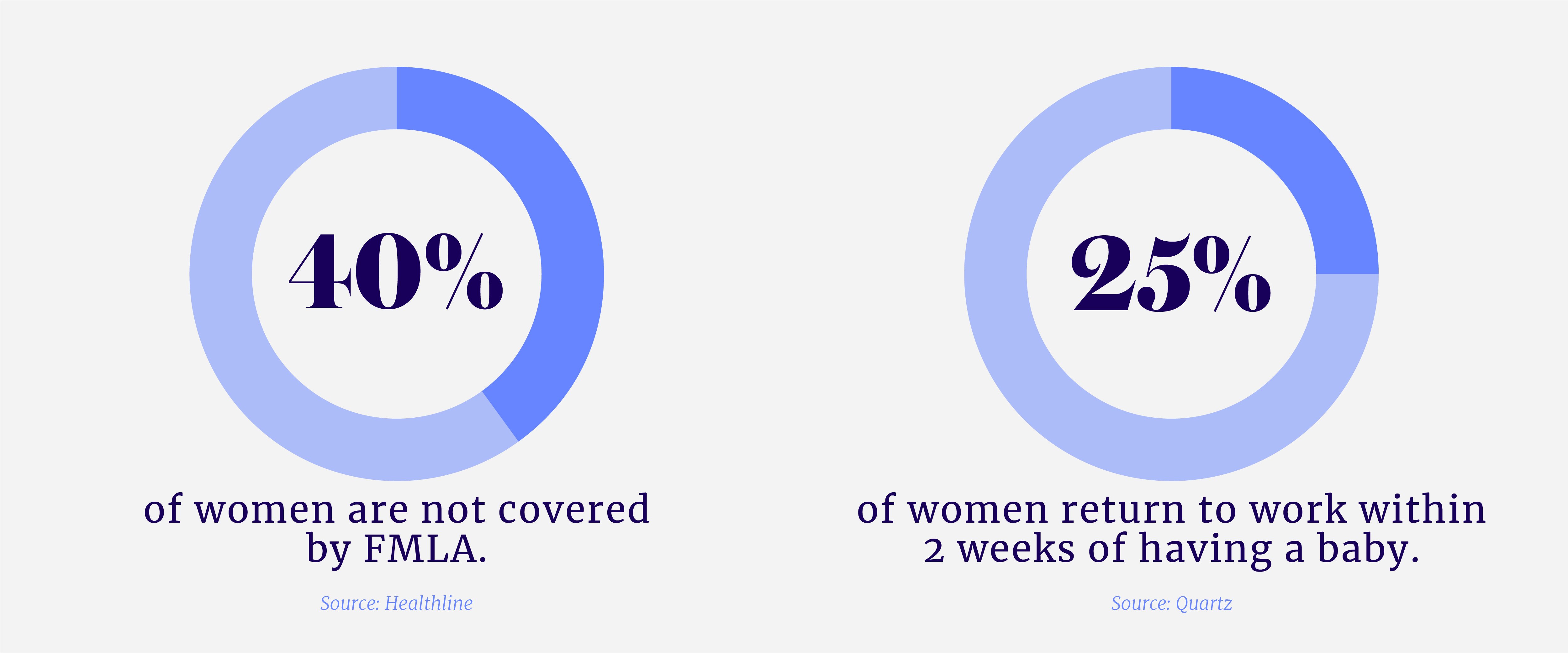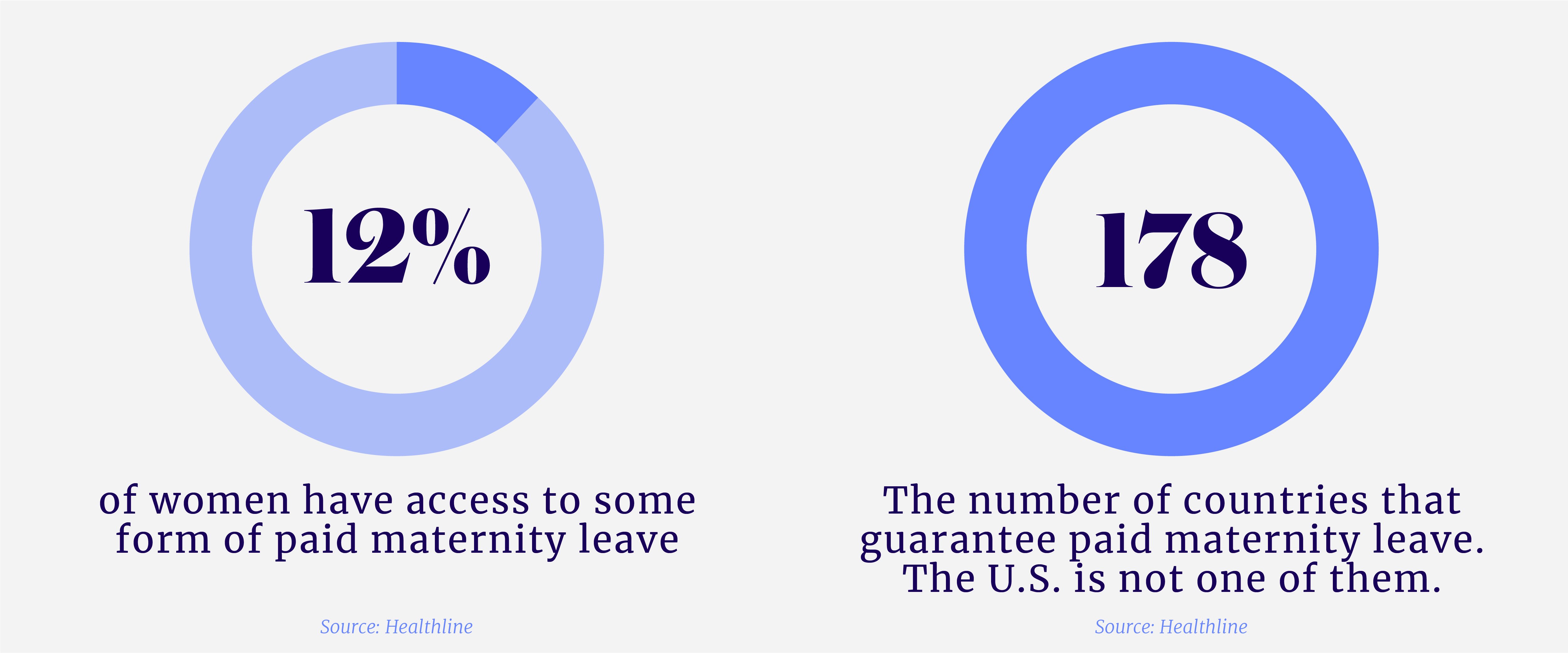
Sharing the news at work that you’re pregnant will bring many well wishes and then, inevitably, the questions begin: How long will you be out? Are you coming back? When is your last day?
When to share the news
There are two schools of thought when it comes to sharing your pregnancy at work. One says wait as long as possible to avoid some of these uncomfortable and intrusive questions as long as possible. The other says share your news as soon as you’re comfortable because this gives everyone around you - and you! - more than enough time to plan for your maternity leave.
No matter when you decide to share your news, it’s a good idea to speak with your manager first and have at least a loose plan for your maternity leave including how long you’ll take, what your schedule might look like when you come back or if you’ll even come right back at all.
Planning your maternity leave
You’ve just found out you’re expecting (maybe for the very first time!) and now you must plan not only for the birth of your child but also for what this means for your job. Planning your maternity leave can be easier if you approach it in three different phases:
|
Phase 1: Planning Your Maternity Leave |
Phase 2: Taking Your Maternity Leave |
Phase 3: Returning to Work |
We’ll walk you through each phase of your maternity leave and help you cover all the essentials.
📖Read More: How to Plan for Your Maternity Leave
Phase 1: Planning your maternity leave
As you begin planning your maternity leave, determine your protections under FMLA, any short-term disability options you may have, your state’s laws regarding maternity leave, and what your company’s maternity leave policy includes.
Maternity Leave Checklist
🗒️Get started early planning your maternity leave with this step-by-step guide.
Know your rights
As you start planning your maternity leave, the first step is understanding your rights as a pregnant woman and new mother. There are no federal laws requiring companies to provide paid leave, but the Family Medical Leave Act (FMLA) does protect a woman’s job for 12 weeks after having a baby. This protection means that you are entitled to return to your same position and pay after having a baby.
Get Started: Watch our Unity Hour: Mothers’ Rights at Work for more information on how to detect discrimination, frame communications with management, and request accommodations before, during, and after maternity leave.
FMLA protections only apply to companies with more than 50 employees. If you work for a small business, your employer may not be required to offer FMLA coverage to you. This is actually fairly common - 40% of women aren’t covered by FMLA.
If your job isn’t protected by FMLA, in order to take the maternity leave you will need to:
- Talk to your employer about other options and how long they’re willing to give you, even if it’s unpaid.
- Utilize all your sick time and PTO immediately after the birth of your baby to give yourself maternity leave while protecting your job.

State-specific laws governing maternity leave vary. At a minimum, your employer is required to abide by both FMLA and any applicable state laws.
It’s important you do your homework. A company’s official policy may not reflect the leave you’re entitled to under FMLA or your state’s laws and you may need to point this out.
Short-term disability insurance can be used to replace lost income due to many conditions that prevent you from working - maternity leave is one of these. Only 17% of employees in the U.S. have access to paid family leave, so short-term disability insurance can protect your income while you’re on leave.

Create a maternity leave plan
Having a solid maternity leave plan will make it easier for your team to adapt to you being out. It also shows your managers that you’re serious about supporting the team during this time and easing the transition both into and out of your maternity leave.
Aim to have your maternity leave plan prepped before your third trimester, just in case you need to bow out early.
Your maternity leave plan should include:
How much time you’ll take off
Some family-friendly employers may offer more than the standard 12-week FMLA leave. You’re not required to take the full 12 weeks offered to you by FMLA, but it’s a good idea to wait at least 6 weeks until you are medically cleared after delivery before returning to work.
The length of your maternity leave will vary depending on your financial situation, your maternal health, and how much time you take off before the birth of your baby. FMLA covers 12 weeks total, and if you have to stop working before delivery because of extenuating health circumstances, this time will count toward your 12 weeks.
It’s a good idea to ask around and see how long other mothers at your company took for their maternity leave. This can give you an idea of what types of exceptions the company may grant.
Start and end dates for your leave
If you’d like to work up until you give birth, you can typically factor this into your plan and simply state that you’ll take 12 weeks (or however long you’re taking) from the delivery date. Employers will usually be flexible with this, but it’s a good idea to have your transition and coverage plan ready at least a couple of weeks before your due date.
How accessible you’ll be on leave
This is a personal preference. Some moms prefer to take their maternity leave and focus 100% on family life. Depending on the circumstances, some moms may feel better being somewhat accessible beginning at a certain point in their leave.
Who will handle your responsibilities
In addition to your maternity leave plan, it’s important to document your processes, projects, and priorities and keep the notes for each current. You can also recommend who you think would be best to cover each responsibility, then review this plan with your manager.
How you’ll transition back to work
If you are interested in taking a phased-in reentry approach or exploring flexible work options, now’s the time to ask. Remember, anti-discrimination laws protect your job throughout your pregnancy and leave. Even if your employer isn’t happy with your ask, your job is protected.
This maternity leave plan should be prepared in a document that can easily be shared with your manager, team members, and HR.
This maternity leave plan should be prepared in a document that can easily be shared with your manager, team members, and HR.
Exploring childcare options
If you’ll be using childcare when you return to work, it’s best to start looking sooner rather than later. Don’t wait until your maternity leave begins. Many childcare providers have wait lists and it’s a good idea to get on a few just in case.
📖Read More: Creating a Childcare Plan
Phase 2: Taking your maternity leave
We’d say this is the easy part now that you’ve planned every detail of your maternity leave, but there are no guarantees! Pregnancy, childbirth, and parenthood can throw you a lot of curveballs. It’s important to check in with yourself frequently during your leave.
If you feel like you’re struggling, you’re not alone. The World Health Organization reports that 10% of pregnant women and 13% of women who’ve just given birth experience a mental disorder, usually depression.
📖Read More: Maternal Mental Health Resources
Unplug as much as possible
This is a special time in your life, and you’re entitled to fully take your planned maternity leave and unplug.
Phase 3: Returning to work
Although it’s important to unplug as much as possible during your maternity leave, beginning to think about your transition back to work a couple of weeks before the big day is a good idea.
Gradually easing into the idea of returning to work and all that comes with it (new priorities, juggling childcare demands, working through sleep deprivation) can help make the transition easier.
This is also an important time to consider your own mental health before you take on the additional stress of work. Returning to work with postpartum depression can add additional stress.
A week before returning to work:
It can be helpful to begin your childcare routine at least a few days before your first day of work. You may experience a lot of conflicting feelings those first few days, and it will be easier to process them when you’re at home.
Use this time to take a close look at your career goals and priorities. It’s possible they’ve changed a bit during your maternity leave and that’s okay.
Once you’re back to work:
Check-in with yourself frequently, and remember that you don’t have to do it all. You have several months of emails and company priorities to catch up on. Set realistic goals for yourself. Be sure to communicate openly with your manager about what you need to be successful during this transition.
📖Read More: How to Prepare for Your Return from Maternity Leave
Need more flexibility?
Once you return to work, you may realize you need more flexibility in order to balance your personal and professional goals. You’re not alone - a WerkLabs study found that flexibility is the number one priority moms have while looking for a job.
📖Read More: Advocating for Job Flexibility
It’s more than jobs. We’re making progress.
The Mom Project supports women throughout their working motherhood journey. Search for career opportunities with vetted, family-friendly employers, and get access to job search tools, career development resources, and a thriving community of moms and allies. 



